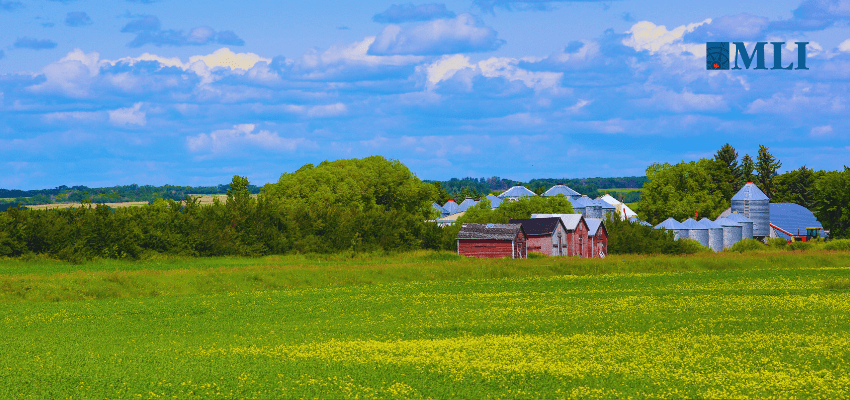By Kristjan Hebert, July 19, 2024
Canada’s agriculture and agri-food system generates around $143 billion, or 7 percent of our gross domestic product, per year. It also provides 1 in every 9 jobs in Canada and employs a total of 2.3 million people. Yet agriculture and food remain a forgotten stepchild to other economic sectors, such as oil and gas and manufacturing, and barely receive a mention at budget time.
Neither does it figure in environmental discussions, despite the fact Canadian farmers are global leaders at sustainable agriculture, as a recent report from the Global Institute for Food Security shows. The federal agriculture minister did not attend COP28 – the UN climate change conference. Minister of Environment and Climate Change Steven Guilbeault did attend, but his agenda didn’t include agriculture.
Two things need to change for Canadian farmers to reach their full potential. One is a more supportive environment from the federal government. The other is for farmers themselves to adopt a more business-minded approach.
Business-savvy family farms
As Western Canadian farmers, we have long painted an idyllic picture of the small family farm on the Prairies.
However, many farms struggle to turn a profit. And many farmers have off-farm jobs just to pay the bills. While we’ve romanticized the lifestyle of farming, we haven’t been very honest about the business of farming.
The truth is, too many small family farms are on life support, subsidized by Canadian tax dollars through government-run insurance programs. Our industry typically resists change. But we need to convince more producers to think like entrepreneurs so they can capture the growth opportunities that lie ahead for Canada’s agriculture industry.
Farm size matters
According to data from the most recent census, there are approximately 189,000 farming operations in Canada. However, only about 10 percent have sales greater than $1 million; those account for more than 52 percent of the sector’s total operating revenues.
The remaining 90 percent of farms are what I would consider a hobby farm. According to widely used accounting benchmarks for top agriculture firms in Canada, a decent EBIT (earnings before interest and taxes) margin is 20 percent. If your revenue is $1 million or less, that leaves EBIT at $200,000 or less. For many farms, that $200,000 will be used for personally held land payments and living costs, which doesn’t leave much for re-investment into the business. To my mind, $1 million in farm revenue is a job, and below that is a hobby. Only above that does it start to be a real business. Small farms provide a great lifestyle, but they are not a great business model.
The reality of agriculture today is that size does matter, and this is why we’re seeing a growing trend towards consolidation. Farms are becoming increasingly sophisticated operations – expanding in terms of equipment, use of technology, sales, employees, and bargaining power.
Suppliers and customers have consolidated as well. We’re seeing significant consolidation among grain elevators, processors, seed, fertilizer and equipment companies. Good luck to any small farm that tries to negotiate or strike a deal with these companies. Those who don’t embrace change won’t survive.
We do not need to do away with the family farm. But farm ownership (and attitudes) needs to be restructured in a way that supports growth, collaboration, and shared equity.
Demographic shift and succession planning
With the average age of the Canadian farmer being 56 and retirement on the horizon, hundreds of thousands of acres of valuable farmland will soon be available. The price of farmland in Canada has increased tenfold over the last three decades. Proper succession planning has never been more important.
Rather than keeping it “all in the family,” what if a retiring farmer’s succession plan involved bringing in non-family professionals to help run the farm – a COO and a fractional CFO – and the family sat as major shareholders? The Cargill family’s agri-business enterprises are the quintessential example. It’s what we did with our family business; my father and I rely heavily on our COO and CFO, with whom we have a profit-sharing arrangement.
The goal is to treat the business as an investment that provides cash for labour, land rent and return on other equity. A farm is really two businesses – a real estate business and a farm operation. These can give the retiring generation certain cash flow, continued equity growth as well as an enterprise that can use the equity to maintain or increase growth. As part of a comprehensive succession plan, the parameters must be set correctly to ensure family equity is not put at significant risk.
It’s an uphill battle getting farmers to realize that genealogy does not always equate to skill. Just because your name is on the farm, it doesn’t mean you need to be the one running it. I think it comes back to our rugged individualism and fierce independence, both a blessing and a curse. Farmers will get the job done, but we’re reluctant to ask for support.
Policy support and better advocacy
That mindset has contributed to a weak policy environment for Canadian agriculture. If we’re thought of at all in Ottawa, it’s often for a policy that neither reflects our interests nor benefits from our input.
Current federal tax policies are hindering growth and expansion. Take, for instance, the carbon tax. It’s a punitive tax for all Canadians but really stings for agricultural producers who must pay the tax when there are no viable alternatives for grain drying and barn heating. At a grain operation in the dead of a Saskatchewan winter, solar and/or wind power simply aren’t going to work! Recent changes to the capital gains tax will also hurt our industry. A larger capital gains tax bill will certainly hinder the succeeding generation’s ability to buy out their parents’ farms and could result in more farms being sold to non-farm, or even international, owners.
Canada is an exporting country and our supply chain, via railways and ports, is vital to our economic stability. Looming strikes, rail disruptions, backlogs at ports – and even the inability to load grain on a rainy day in Vancouver – hurt our reputation as a reliable trading partner. This is something I heard while attending COP28 last fall – that Canada couldn’t be counted on. We need strong federal leadership in this area. If we continue to disappoint our customers, they will go elsewhere and turn to other countries with more reliable infrastructure.
It is frustrating to hear our federal government consistently tell Canadian producers that we can do a better job of reducing our emissions without giving credit to Western Canadian farmers who pioneered no-till (minimum tillage) farming – a practice that helps to sequester carbon in the soil. Under the federal Greenhouse Gas Offset Credit System, early adopters of no-till farming are prohibited from participating in the carbon market. Only projects that started after 2017 will qualify, and backcasting to 2017 has been made nearly impossible. There seems to be no acknowledgment that agriculture holds significant potential as a carbon sink.
Industry needs a unified voice
As the demographics shift and the number of farms decreases in the years to come, it becomes even more important for agriculture to have a unified and informed voice in Ottawa.
We have far too many lobby groups, grower groups, and crop councils. While these groups have an important role in terms of check-off collection to support research and development, international markets, and advocacy, I believe they struggle to influence policy due to their fragmentation. Their work is often reactive versus proactive, always fighting back against bad policy, proposed changes, or global issues. When a minister is faced with more than 400 strategy groups, the easiest route is to do nothing. We need more than photo ops with the agriculture minister on social media. We need size, knowledge, and influence to protect the very thing we are trying to preserve – the family farm.
Agriculture as a whole (and especially crop producers) needs to agree on 80 percent of the policy strategy. In a perfect world, this would also be part of a national natural resource strategy where energy, critical minerals, and agriculture band together to agree on 80 percent of the issues and policies. Canada can be an energy and resource superpower; but it can be an agricultural one as well – helping to provide food security to not only ourselves but our allies around the world.
Canada can feed the world with healthy, safe, ethically produced, and sustainable crops. But to ensure future growth and investment, we need to collectively shift our mindset. We need to finally start running our farms as businesses, while pushing government for increased support through sound policies that allow agriculture to grow and thrive.
Kristjan Hebert is the president of the Hebert Group, which operates a 40,000-acre grain and oilseed farm near Moosomin, Saskatchewan.







